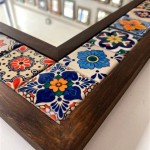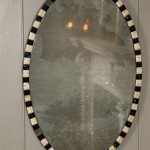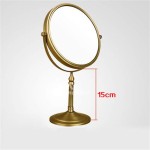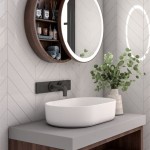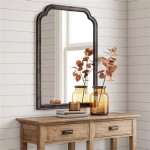Tall Thin Antique Mirrors: A Reflection of Elegance and History
Tall, thin antique mirrors offer a unique blend of functionality and historical charm. Their slender silhouette adds a touch of verticality to any room, while their aged patina speaks to a bygone era. These mirrors, often found in antique shops, estate sales, and online marketplaces, can serve as striking focal points and conversation starters.
The history of tall, thin mirrors is intertwined with the development of mirror-making techniques. Early mirrors, made from polished metal, were expensive and relatively small. The development of glass mirrors backed with reflective coatings, particularly silvering in the 16th century, allowed for the creation of larger and more affordable mirrors. However, creating large sheets of flat, flawless glass remained challenging. This, coupled with the vertical emphasis in interior design trends of certain periods, like the Victorian and Art Deco eras, contributed to the popularity of tall, narrow mirror designs.
Several distinct styles characterize antique tall thin mirrors. Cheval mirrors, featuring a full-length mirror mounted on a frame with adjustable tilting, were a common fixture in bedrooms and dressing rooms. Pier mirrors, originally designed to be placed between windows, were often tall and narrow to maximize light reflection and create an illusion of greater space. These mirrors typically featured decorative frames and were sometimes topped with a shelf or small console. Other styles include trumeau mirrors, which incorporate a painting or decorative panel above the mirror, and hall mirrors, frequently placed in entryways for a final check of appearance before leaving the house.
The frames of these antique mirrors offer a wealth of historical detail. Carved wood frames, often featuring intricate floral motifs, acanthus leaves, or geometric patterns, are a testament to the craftsmanship of the past. Gilded frames, created by applying gold leaf or paint, add a touch of opulence and grandeur. Some frames might incorporate other materials such as gesso, plaster, or ebonized wood, each contributing to a distinctive aesthetic.
The age of a tall thin antique mirror contributes significantly to its value and character. Determining the age requires careful examination of the mirror itself and its frame. The type of glass used, the backing material, and the construction techniques can offer clues about the mirror's origins. For example, early mirrors often feature imperfections in the glass surface, while later mirrors exhibit greater clarity. The frame's style and ornamentation can also help date the mirror, reflecting prevalent design trends of specific periods.
When incorporating a tall thin antique mirror into a modern interior, several factors should be considered. The mirror's size and proportions should be in harmony with the surrounding furniture and architectural features. A large, ornate mirror might overwhelm a small room, while a smaller, simpler mirror could be lost in a grand space. The mirror's style should also complement the overall aesthetic of the room. A gilded Rococo mirror might appear out of place in a minimalist, contemporary setting, while a simple, framed mirror could enhance its understated elegance.
Placement plays a crucial role in maximizing the impact of a tall thin antique mirror. Positioning it opposite a window can amplify natural light and create a sense of spaciousness. Leaning it against a wall offers a casual, bohemian vibe, while hanging it securely provides a more formal look. The mirror can also be used to highlight a specific architectural feature or piece of furniture, drawing the eye and adding depth to the room.
Caring for tall thin antique mirrors requires attention to their delicate nature. Dusting the frame regularly with a soft cloth helps prevent the buildup of grime. Cleaning the mirror surface should be done with a gentle, non-abrasive cleaner and a soft lint-free cloth. Avoid using harsh chemicals or abrasive materials, which can damage the delicate silvering or other reflective coatings. Handling the mirror with care, especially when moving it, is essential to prevent cracks or damage to the frame.
The presence of a tall thin antique mirror can significantly enhance the ambiance of a room. It serves not just as a reflective surface but also as a piece of art, reflecting both the image of the observer and the echoes of history. Its elegant form and aged patina can add a touch of timelessness and sophistication to any interior, creating a space that is both visually appealing and historically rich.
Acquiring a tall thin antique mirror can be a rewarding experience. Whether found in a local antique shop, an online auction, or a family heirloom, these mirrors offer a unique blend of beauty and history. Their presence in a home serves as a constant reminder of the craftsmanship and artistry of the past, adding a layer of depth and character to the present.

Antique French Style Wall Mirror Tall Narrow Gold Shabby Chic Mirrors

Tall Narrow Louis Xvi Style Trumeau Wall Mirror Gold Gilt Wood Antique

Pin On Hallway

Slim Wall Mirror Antique French Style White Shabby Chic

Exceptionally Tall Narrow Antique French Giltwood Mirror

Long Narrow Mirror Wall Art 35 8 Tall Decorative From Peru Painting On Glass Antique Gold Wood Framed Accent Mirrors

Set 2 Narrow Baroque Wall Mirrors Antique Gold 60h Accent Patina Pair Horchow Big Mirror Bedroom

Large 19th Century French Giltwood Mirror For At 1stdibs

Tall Antique Swedish Rococo Style Pier Mirror For At Pamono

Exceptionally Tall Narrow Antique French Giltwood Mirror

